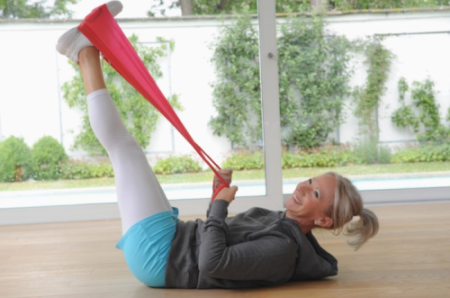
Osteoporosis is one of many health concerns for midlife women. Your bone health can be protected with proper nutrition including adequate calcium and vitamin D. Avoiding smoking and excessive alcohol consumption also slows bone loss, but medication may be necessary if it becomes severe. The other ingredient for good bone health and osteoporosis prevention is exercise.
Posture Is Primary
The most important exercise for your bones is developing and maintaining good posture. No amount of exercise will undo 16 hours of bad posture a day. Think about sitting and standing as tall as possible, pulling your belly button towards your spine, lowering your shoulders, and gently drawing your shoulder blades together. Place a mirror in a location where you will see yourself frequently so you will be reminded if you start to slouch.
Three Types of Exercise for Your Bones
Develop a plan for weight-bearing, strength-training, and balance exercises. These have all been shown to improve the health of your bones and decrease the risk of falls. Inactivity such as prolonged bed rest, limb immobilization, or spinal cord injury can cause skeletal loss. An increase in bone mass results from activities that apply stress to bone and increase muscle mass and strength. Extreme exercise is not necessary. Even mild forms of exercise that improve agility and balance can be beneficial.
Weight-bearing exercise means carrying your body weight in activities as simple as:
- Brisk walking with a backpack or pocketed vest. You can slowly add weights (up to 10% of your body weight) to strengthen ankles, knees, and hips.
- Jogging and running provide benefits to the skeleton.
- Lunges (forward, sideways, and rear) are particularly beneficial in reducing risk of falls by maintaining muscle strength, agility, and balance.
- Other sociable options include tennis and dance.
- Jumping is excellent for building strong bones but be sure to strengthen your ankles, knees, and hip joints first.
- You may enjoy exercising in the swimming pool or on a bicycle, and these can be very good for your heart, but note that they are not considered weight-bearing exercises to strengthen your bones.
Strength-training exercises can include the use of resistance machines or inexpensive equipment:
- Use resistance bands, free weights, or barbells.
- Target specific muscle groups (the large extensor muscles of the back; the hip flexors and extensors; muscles of the thigh, upper arm, and forearm) in order to affect areas of the skeleton most often involved in osteoporotic fractures.
- To strengthen your back, perform gentle spinal extension exercises while seated (sit tall, look up toward the ceiling, and arch your back) and lift the lower ribs off the pelvis.
Balance work should begin with a chair for support, especially if you already have osteoporosis. While holding the chair, practice standing on one foot at a time. Gradually, work up to balancing on one foot without using the chair.
- Advanced activities include tai chi and yoga, which improve muscle strength, flexibility, and balance.
- Note that yoga can be both beneficial and risky in women with osteoporosis. There is controversy regarding the safety of some of the spine-twisting positions in yoga.
- Toe touches and sit-ups should be avoided because they increase the weight placed on the spine, which may result in spine fracture in high-risk women.
How Often Do I Need to Exercise?
Studies show that exercising for 45 to 60 minutes three times a week maintains bone strength. Your bone gains start to diminish if you stop exercising, so vary your exercise routine to stay interested. It is never too late to reduce your risk of osteoporotic fracture.
For more, see Exercise for Your Bone Health from the National Institutes of Health.
Image credit: Copyright © Microsoft. Used with permission.